While reviewing comments on WPBeginner, we noticed a common frustration among readers: losing important form submissions because they were only stored in email.
It’s a problem we faced ourselves when we first started building WordPress sites.
The truth is, most WordPress form plugins don’t automatically save entries to your database. They just send an email — and hope you don’t accidentally delete it or need to find it later.
But what if you want to track your leads or analyze submission trends over time?
In this guide, we’ll show you exactly how to store all your contact form data safely in your WordPress database. These are the same methods we use across our own business sites to make sure no form submission ever gets lost.

Contact Forms and the WordPress Database (Behind the Scenes)
When a visitor submits their details in a contact form on your WordPress site, the most prominent visible action that you, as a website owner, will see is an email notification in your inbox. It contains all the details that a specific visitor submitted.
However, behind the scenes, most WordPress form plugins will also store this data in your WordPress database.
A WordPress database is a system for storing and fetching data in an organized way. It allows plugin developers to manage data in a programmable way.
As a user, if you wanted to display the data in your WordPress database, then you would need to log in to your WordPress hosting account and open the phpMyAdmin tool.
For example, if you are using Bluehost, then the link to phpMyAdmin is located in the panel on your left. Simply go to Advanced » phpMyAdmin from your Bluehost dashboard.
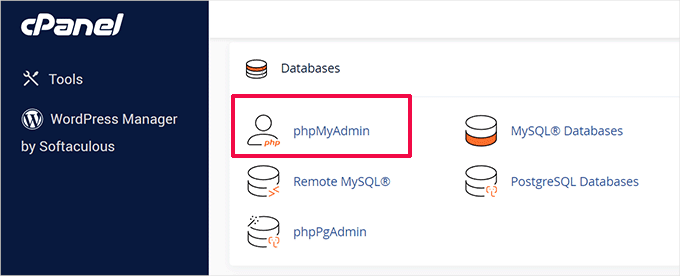
Once you are in phpMyAdmin, you need to select your WordPress database, then click on the database table of your respective WordPress form plugin.
Since we use WPForms, this is our form table: wp_wpforms_entries.

Once you have clicked on the table, you will find all your form entries in the ‘field’ column.
You will probably agree with us when we say that this is not the most user-friendly way to see data.

This is why most premium WordPress form plugins come with a user-friendly entry management solution that allows you to access form entries inside your WordPress dashboard.
All contact form data is still stored in your WordPress database, but you can view it in a user-friendly interface like your WordPress admin instead of the screenshot above.
Let’s see how you can easily manage your form entries in WordPress. Here are all the topics we’ll cover in this guide:
How to Manage Contact Form Entries in WordPress
For this tutorial, we will be using WPForms. It is the best WordPress contact form plugin that helps you manage your form entries with ease.
However, a similar process exists for other popular WordPress form plugins, including Formidable Forms.
📝 Note: We use WPForms across our sites to display our contact form, annual reader surveys, and more. See our complete WPForms review for more insights about the plugin!
First, you will need to create a contact form with WPForms. If you need instructions for this, then you can follow our step-by-step guide on how to create a contact form in WordPress.
After you have added the contact form to your WordPress website, you need to go ahead and make a test entry submission. Here is an example of our simple contact form.
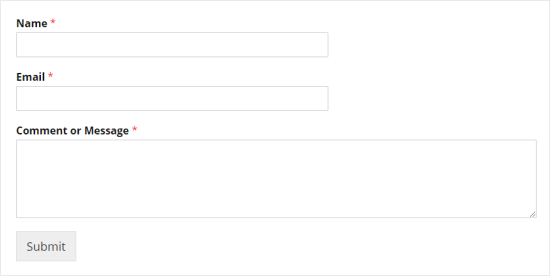
Once you have filled it out with sample information, click on ‘Submit.’
This will cause two things to happen. First, it will send you, the site admin, an email with all the information from the form.
Second, it will store the contact form data in your WordPress database that you can view by going to WPForms » Entries in the WordPress dashboard.
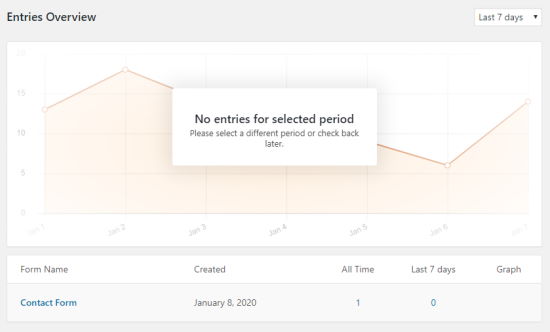
On this screen, you will see different forms and their entries.
You can click on your form’s name or the count under ‘All Time’ to see your entry.

The entry management screen allows you to star (favorite) entries in the table, mark them as read, or even delete them.
You can click on the ‘View’ link next to the entry item to see more details, such as the date of submission, other contact form fields, and more.

On the WPForms ‘Entry Details’ page, you can add notes about the contact form entry, print or export it, star it, and more.
As a user, this interface is more user-friendly compared to viewing the contact form data stored in a WordPress database.
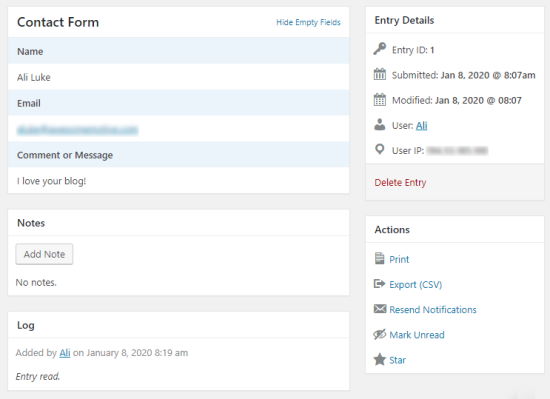
Now that you know about forms and databases, let’s see how you can save space by preventing form entries from being stored.
Bonus Tip: How to Disable Form Data from Being Stored in WordPress Database
In some cases, you may not want to store your contact form data in a WordPress database. WPForms also allows you to do that.
All you need to do is edit the WordPress form, and it will open the WPForms form builder.
You need to go to the Settings » General tab inside the builder and scroll to the bottom. Next, make sure to check the ‘Disable storing entry information in WordPress’ option.
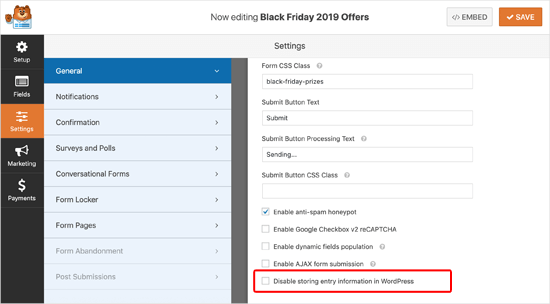
After that, simply click on the ‘Save’ button, and you are done.
Now, you need to go back to this form and submit a test entry to make sure that you are receiving email notifications. This is very important because the contact form entry will NOT be stored in the database when you have the above setting checked.
If you are running into the WordPress not sending email issue, then you will need to install and activate the WP Mail SMTP plugin.
It helps you improve WordPress email deliverability by letting you connect with top SMTP providers like Amazon SES, SendGrid, and more.
Video Tutorial
Learning by watching? Here’s our video tutorial on how to save contact form data in the WordPress database:
We hope this article helped you learn how to save contact form data in the WordPress database. You may also want to see our expert tips for conditional logic use cases to improve your forms and our ultimate guide to using WordPress forms.
If you liked this article, then please subscribe to our YouTube Channel for WordPress video tutorials. You can also find us on Twitter and Facebook.





Jiří Vaněk
This is exactly the reason why I switched to the paid version of WPForms. Because I can see all the forms nicely in the WP administration. WPForms is a great plugin and the paid version is a joy to work with.